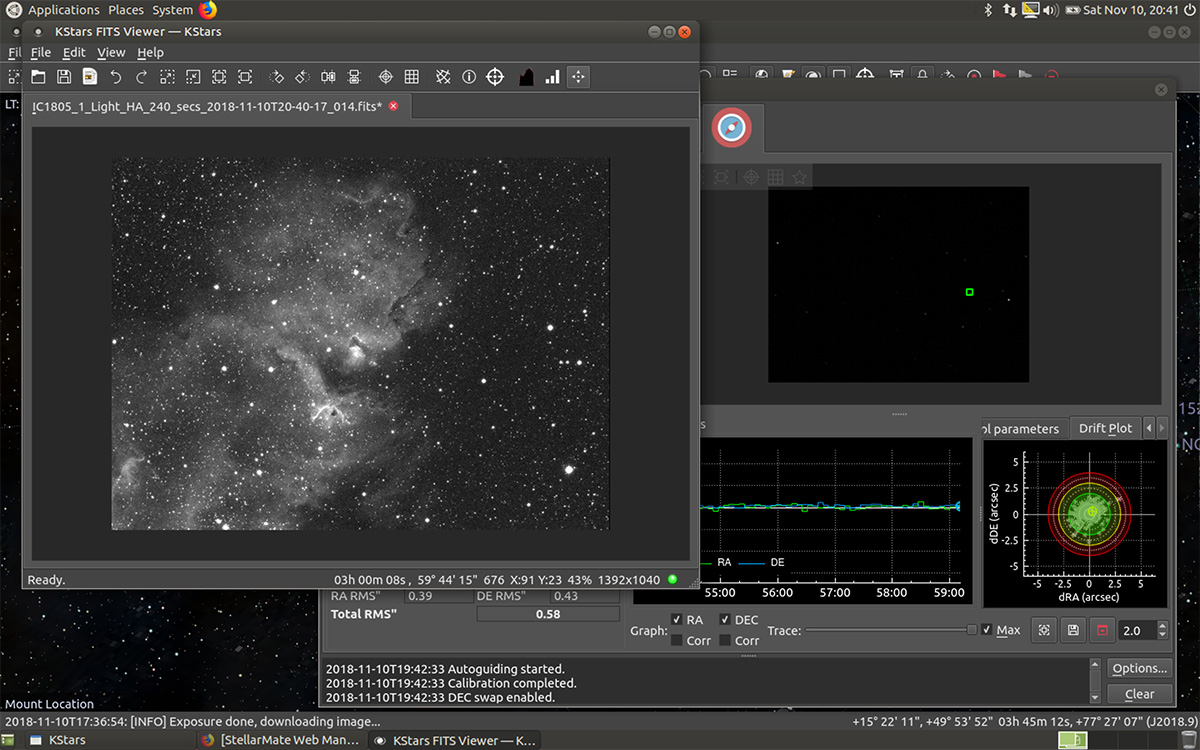Wide Field, Narrow Band
Going to run some manual focus tests on my wide-field narrowband setup, if I can see the stars tonight. I just want to see if I have the backfocus correct for the Nikon f/2.8 180mm lens. I'm using a 2" Optolong 7nm Ha filter with the Atik 414EX mono CCD camera. No guiding with this tonight, but normally I would have the 130mm guide-scope and ZWOASI120MM-S on top of the aluminum camera/lens ring (ZWO 78mm Holder Ring for ASI Cooled Cameras). My hydrogen-alpha filter is in the AstroShop 2" Filter Drawer System with the tripod foot, which just adds more stability to this setup. You may also notice--if you're familiar with the iOptron CEM25P--that I'm using the short counterweight bar with a single weight. I can carry this whole rig around without taking anything apart.

Posted July 5, 2019
Lobster Claw Nebula in Ha + OIII
The "Lobster Claw Nebula" (Sh 2-157), an emission nebula in Cassiopeia, and Sh 2-157a a ring nebula around the Wolf-Rayet star WR 157. I finally captured hydrogen-alpha and oxygen-3 frames for one of my favorite Sharpless catalogue objects. I will come back later in the year to get better OIII frames and an SII set. I didn't get to the underside of Cepheus--or the borderlands between Cepheus and Cassiopeia until 1:30 am, and by then I only had an hour and a half of astronomical night left. This time of year the sky begins brightening at 3:30am, which makes it tough to get to some of these later objects.

Posted July 3, 2019
Elephant Trunk Nebula
I hung around Cepheus and shot several hours of sub-exposures last night, mostly focused on IC 1396, the "Elephant Trunk Nebula", which is easy to make out near the center of the frame. This giant ionized gas region in Cepheus has some amazing dark bands of dust and other interstellar debris, blocking the light of more distant stars. Like there's that little guy on the right I want to call the "Harry Potter casts an Imperio" nebula. Imaging notes: bi-color made up of 48 stacked subs in Ha and OIII, William Optics GT81 APO refractor, ZWO ASI1600MM-Pro mono camera, Astronomik filters, iOptron CEM25P mount.
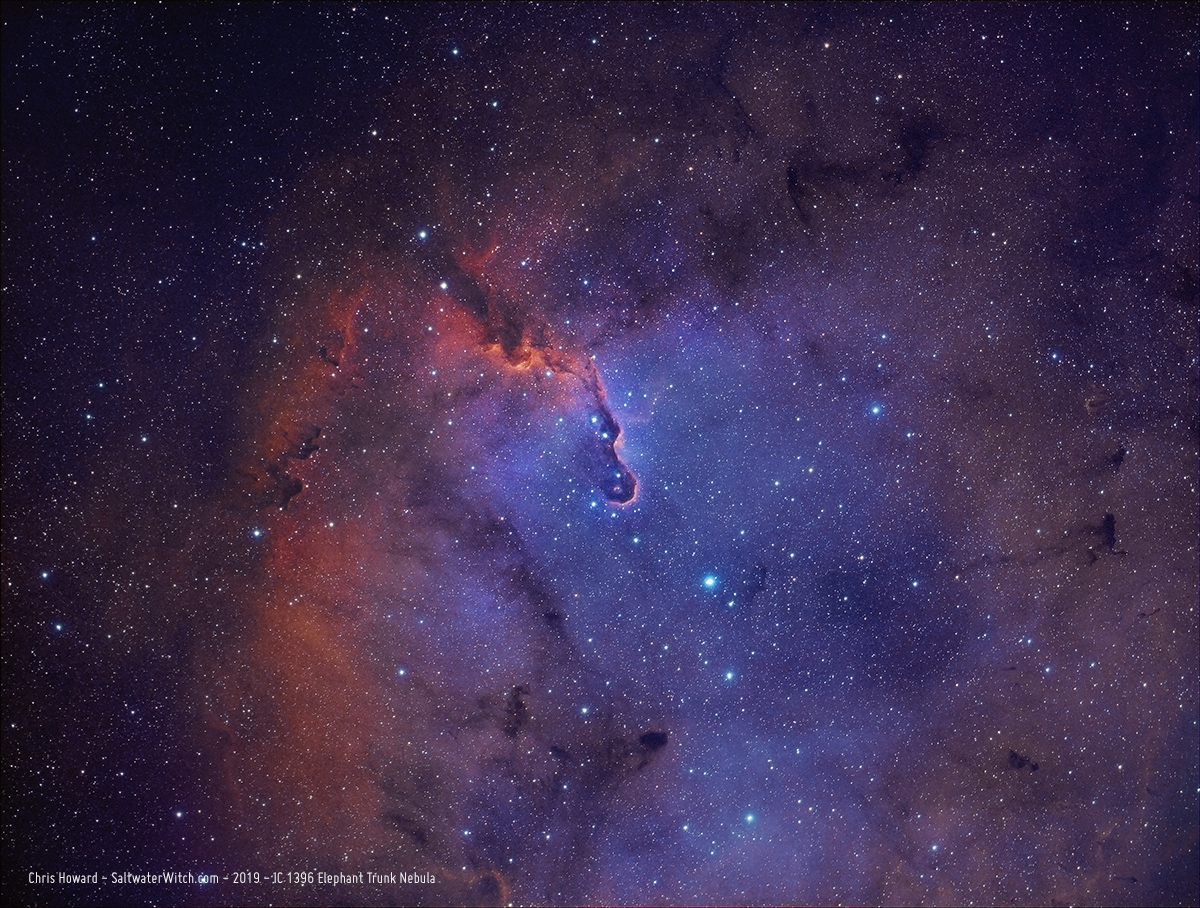

I also shot RGB subs. Here's the HaRBG:

Posted July 3, 2019
More from Cygnus: Crescent and Tulip Nebulae
The Crescent Nebula, NGC 6888 (top right) is an emission nebula in the constellation Cygnus, about 5000 light-years away. Like most of this region around Cygnus, you can't do anything in hydrogen-alpha or sulfur2 without wading through clouds of the stuff—billowing, eddying, and general nebulousing. It's beautiful. There's a Wolf-Rayet star, WR 136, at the lower left edge of the Crescent Nebula (from this angle), and it's stirring up violent stellar winds and blazing quickly through its life; it's expected to go supernova in a couple hundred thousand years, and it's only a four or five million years old. WR stars are unusual: they're very bright--thousands of times brighter than our sun, and they burn much hotter, thousands of times hotter than almost all other stars. And they have very short lifespans.
Notes: 31 x 240 sec Ha, 33 x 240 sec OIII, 29 x 240 sec SII, Astronomik Ha, OIII, and SII filters, William Optics GT81 at f/4.7 with WO 0.8x Flat6A II, Moonlite focuser, ZWO ASI120MM OAG, Imaging camera: ZWO ASI1600MM Pro cooled mono on an iOptron CEM25P mount.
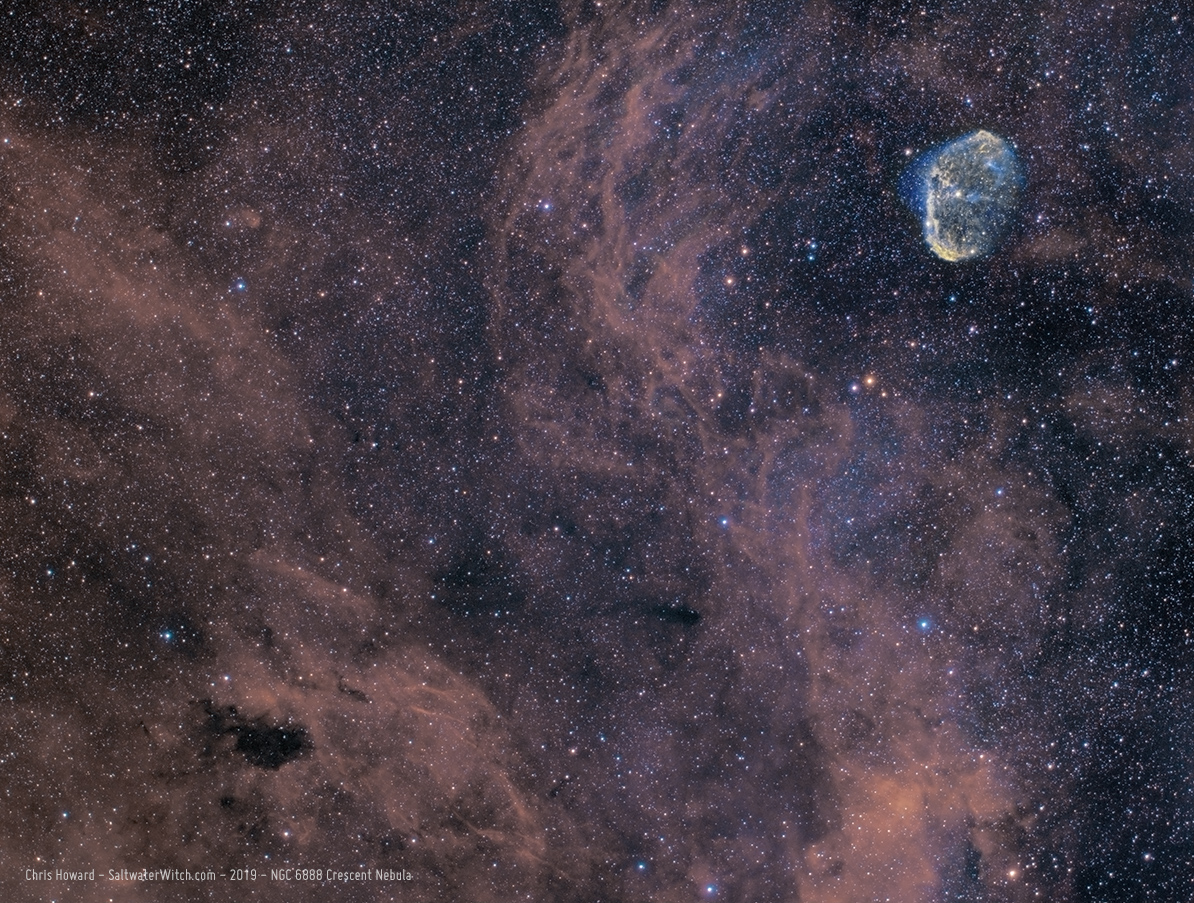
Sharpless 2-101, the Tulip Nebula (top left) is an emission nebula in Cygnus, about 6,000 light-years away. The microquasar Cygnus X-1 is the bright star just above the top point of the Tulip in this image. Cygnus X-1 is famous for being one of the first suspected blackholes, as well as a famous bet between physicists Stephen Hawking and Kip Thorne over that possibility. Hawking conceded to Thorne in 1990 as evidence for a blackhole mounted. Although the Tulip (Sh 2-101) stands out brightly with oxygen in blue, the whole region around the constellation Cygnus is cloudy with interstellar dust and gas. Notes: Astronomik Ha, OIII, and SII filters, William Optics GT81 at f/4.7, ZWO ASI1600MM Pro cooled mono camera, on an iOptron CEM25P mount.

Posted June 12, 2019
Eagle Nebula - wide-field view with a side-order of infrared
Here's another one from last night's run, a wide-field view of the Eagle Nebula (M16, NGC6611) in IR-OIII-Ha with Ha luminance. From our perspective Messier 16--Eagle Nebula--sits just north of the Milky Way's dense core of stars, bands of clouds, dust, hydrogen, and other galactic detritus. I wasn't very hopeful with the IR subs, but the Ha subs were beautiful. The OIII frames were about what I expected--not too much but enough to include them. To brighten things up I went back and added the processed Ha stack as a luminance layer. Yes, this may be a spectacularly weird color arrangement, but we're working in false color imaging already, and this doesn't seem that far off from our galaxy's actual core colors--at least in terms of the bands of dust and ionized gases.
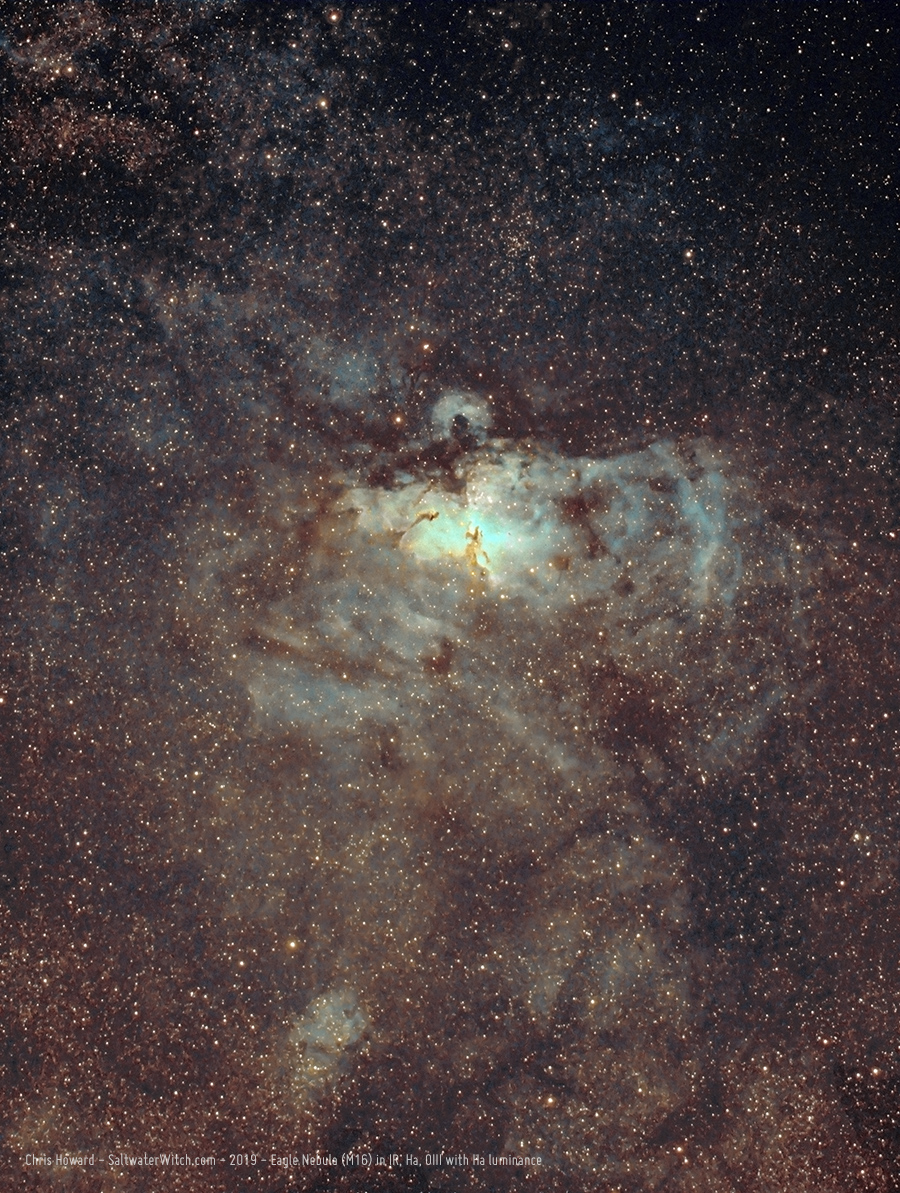
Here's the Ha stack:
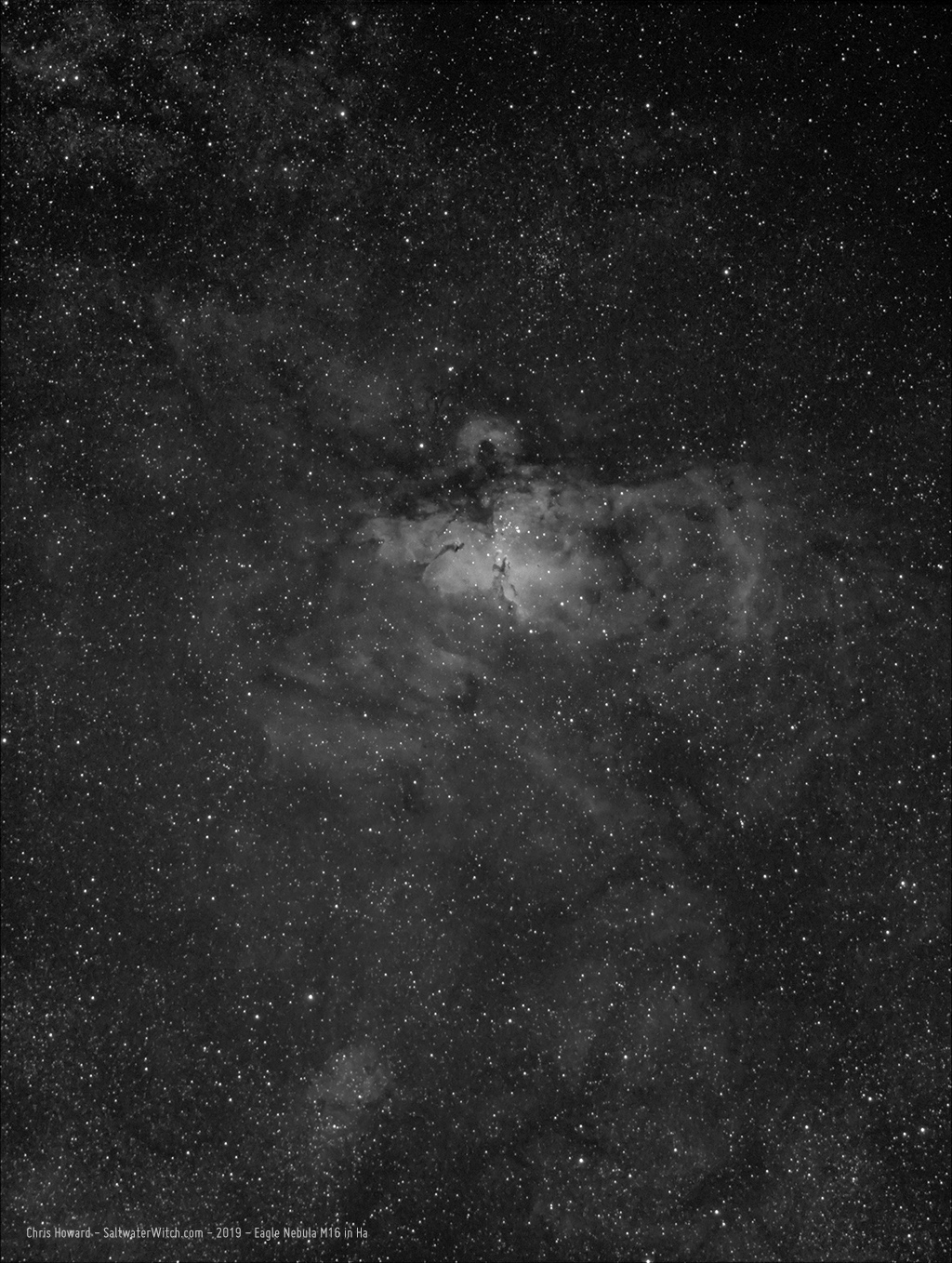
For comparison (with NGC 6611 above), here's the processed version of the Eagle Nebula (M16) I took last year with a slightly different setup--same William Optics scope + Atik414EX mono CCD camera. This is a bi-color hydrogen-alpha and oxygen3. With this one I think I had my OIII frames mapped to G and B channels, and Ha mapped to the Red channel.
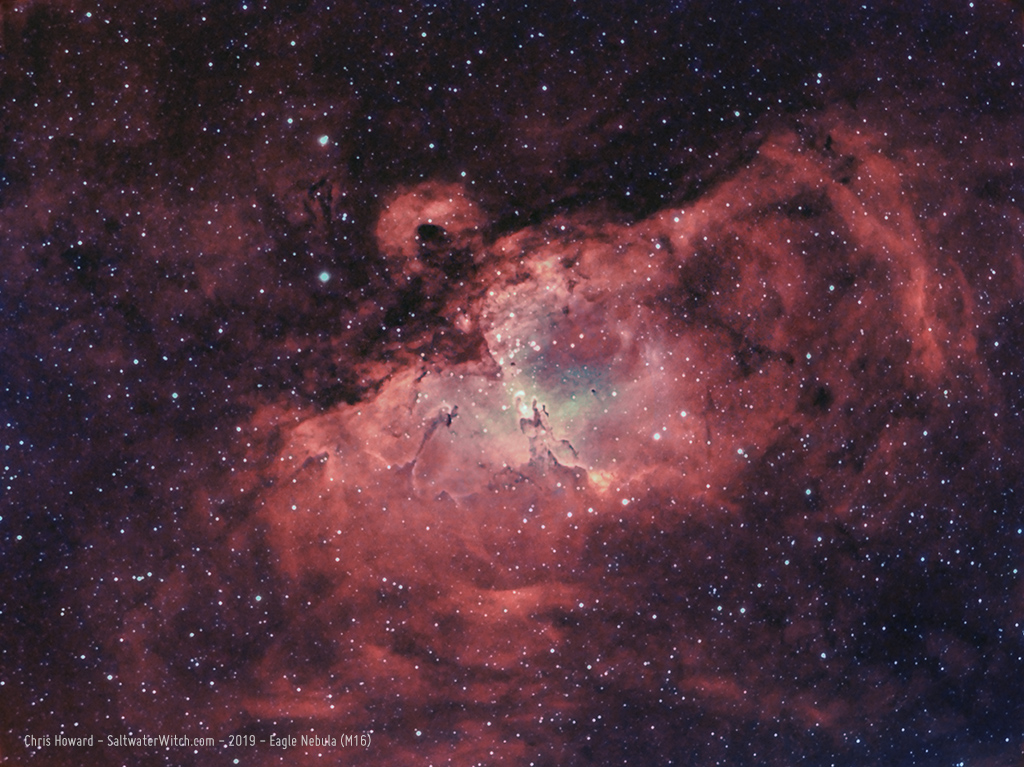
Posted May 25, 2019
NGC 2174 in the Hubble Palette and Bi-color HO
NGC 2174, the Monkey Head Nebula. I went with the Hubble Palette, SHO, on this one. Exposures: 24 x 120 seconds Ha, 26 x 120 seconds OIII, 24 x 120 seconds SII. Equipment: William Optics GT81 APO refractor, ZWO ASI1600MM-Pro monochrome 16MP camera (unity gain 139/21), Astronomik filters, iOptron CEM25P mount, INDI/Ekos/KStars control software. NGC 2174 is a faint emission nebula located in the constellation Orion, about 6400 light-years away. This was a test of my field setup that I'll taking on the road in a week. I'll have to come back to NGC 2174 with longer exposures--and more of them. And dark frames. I didn't shoot any calibration frames in this run.

Here's my processing of NGC 2174 in Hydrogen-alpha and Oxygen (without the Sulfur frames).

Posted February 22, 2019
California Nebula - NGC 1499 Bi-color Ha + SII
NGC 1499, California Nebula in bi-color narrowband hydrogen-alpha and sulfur 2. I captured this data on the 25th, but didn't have time to capture oxygen 3 frames with high clouds moving in and the moon rising. Even so, I like the way this turned out with the two bandpasses, almost fluorescent. NGC 1499 is about 1000 lightyears away, and if you haven't guessed, it's called "California Nebula" because if you flip this image 90 degrees counterclockwise it looks like the state.

Posted December 28, 2018
Astro Session - November 10, 2018
Soulful Friday--more importantly it was a cloudless Friday on the 10th. I'm going to have to do a mosaic for the whole thing, but for now here's the southern end of IC 1848, the "Soul Nebula" in Ha and OIII (Soul is also identified as Westerhout 5 and Sh 2-199). IC 1848 is in the constellation Cassiopeia, and what you see here is a bit more than half the 100 lightyears in length of the whole nebula--so what is that, something like 588 quadrillion miles from top to bottom? At 6,500 light-years away, that will make a nice four panel mosaic. (Notes: 40 x 240 seconds in Ha, 28 x 600 sec. in OIII. Atik 414EX mono CCD, Astronomik 12nm Ha, OIII filters, William Optics ZS61 + WO Flat F6A f/4.7, iOptron CEM25P EQ mount, Orion OAG + ZWO ASI120MM-Mini guide cam, Stellarmate OS (INDI/KStars/Ekos) running on Raspberry Pi 3b+)
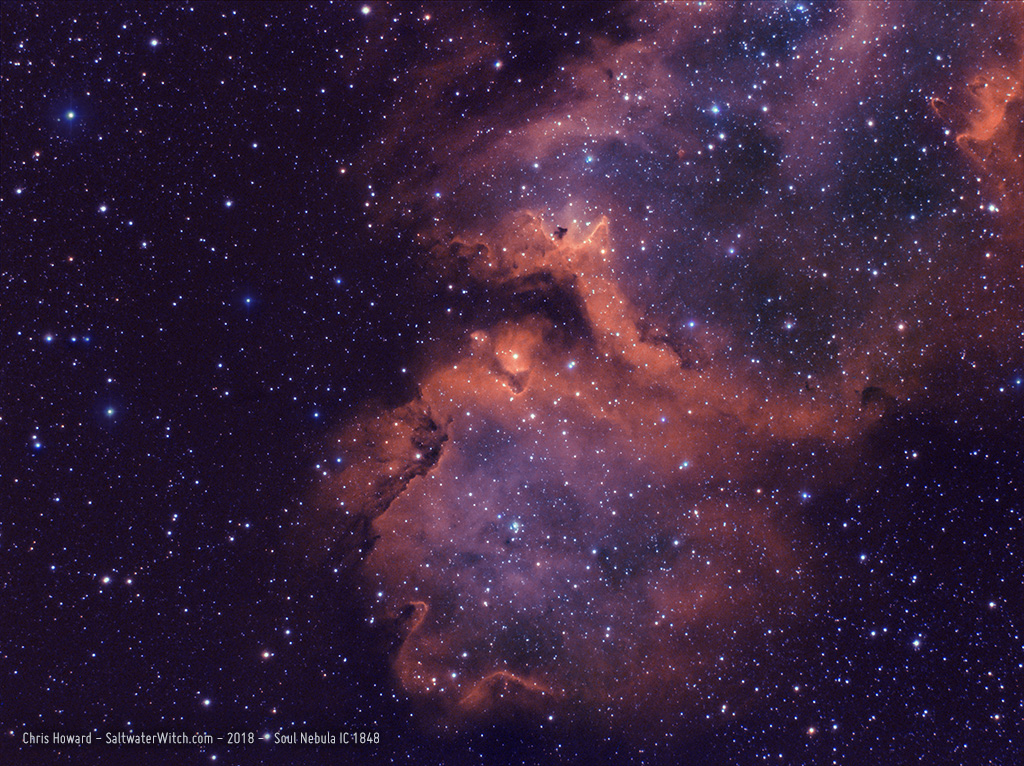
This is the first time I've captured any subs of NGC 2264, the Cone Nebula, about 2600 light-years away (800 Parsecs) in the constellation Monoceros. NGC 2264 includes several identified objects, including the Cone Nebula, Fox Fur Nebula and a massive variable star system, the Christmas Tree Cluster at its core. (Notes: 61 x 300 seconds in Ha, 48 x 300 sec. in OIII. Atik 414EX mono CCD, Astronomik 12nm Ha, OIII filters, William Optics ZS61 + WO Flat F6A f/4.7, CEM25P EQ mount, Orion OAG + ZWO ASI120MM-Mini guide cam, Stellarmate OS (INDI/KStars/Ekos) running on Raspberry Pi 3b+)
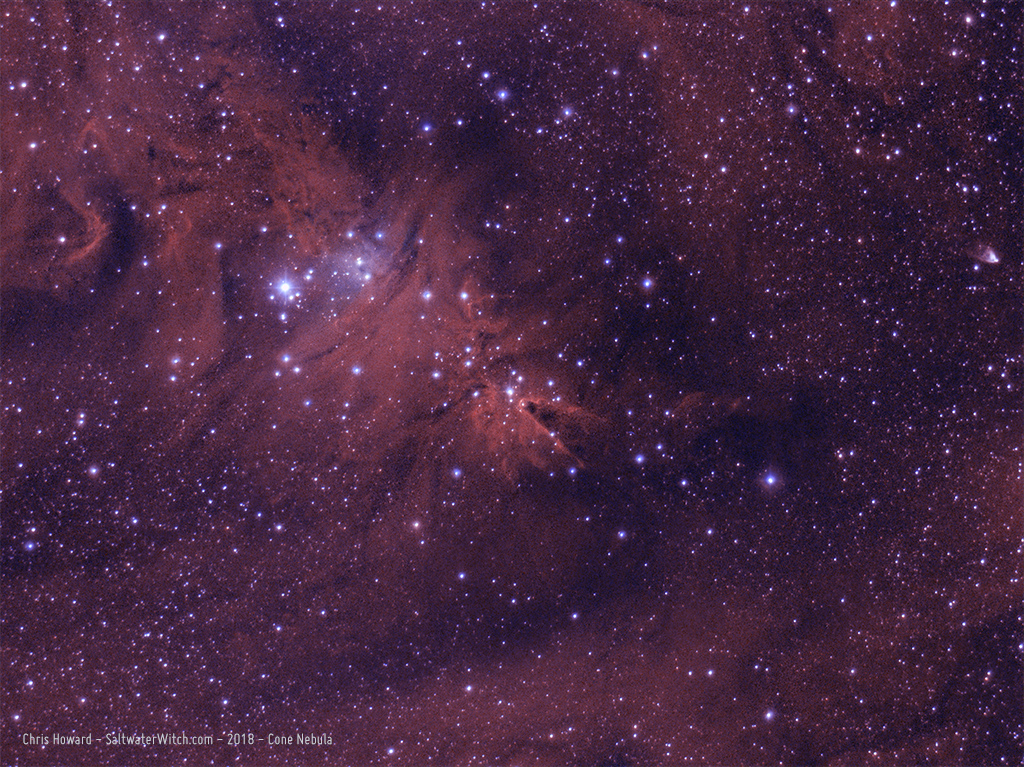
Near-Infrared: I also captured 40 frames of M78, a reflection nebula in the constellation Orion. I captured 20 of each in Ha (~656nm) and infrared with the 685nm longpass filter to see what showed up, and was surprised by what I could see in the unstretched subs. There really is a lot going on at the red end of the spectrum--and beyond, and I combined both of them in this shot, divided evenly across RGB (R=Ha, G=50%Ha/50%IR, B=IR). The plan is to come back with a set of color frames and see if I can combine the whole set.
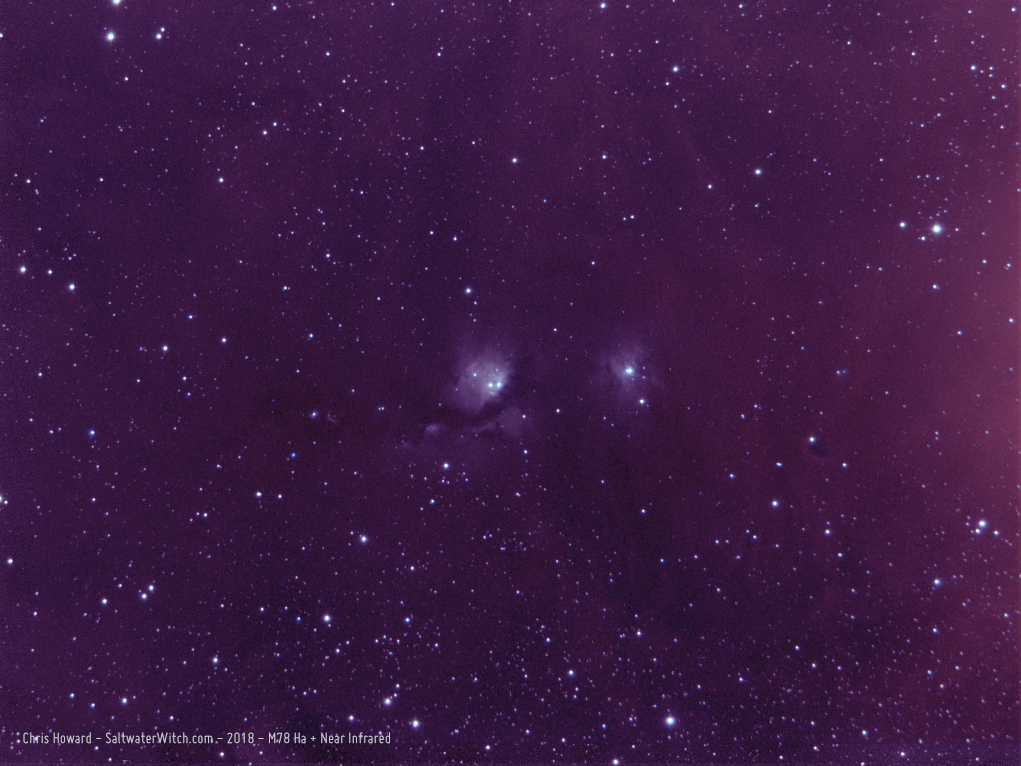
I took some pics of my narrowband setup for this imaging run, before nightfall and in the middle of shooting frames for the Cone Nebula just before Meridian Flip.

Here's a screenshot of Ekos and KStars running, with the guiding tab opened. It was pretty windy, so an RMS" of 0.58 is great, but overall my guiding has improved since going to an Off-Axis Guider. I'm now using the Orion Thin OAG on both trains--color and narrowband, and the difference is noticeable. It took some time to dial sensor and focus distances in, but results are clear, and I just don't think I'll ever go back to a guide scope.
